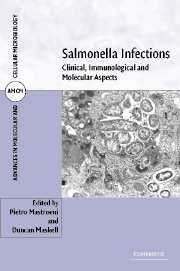Book contents
- Frontmatter
- Contents
- List of contributors
- Preface
- 1 Epidemiological and clinical aspects of human typhoid fever
- 2 Antibiotic resistance in Salmonella infections
- 3 Host-specificity of Salmonella infections in animal species
- 4 Public health aspects of Salmonella enterica in food production
- 5 The Salmonella genome: a global view
- 6 Pathogenicity islands and virulence of Salmonella enterica
- 7 In vivo identification, expression and function of Salmonella virulence genes
- 8 Mechanisms of immunity to Salmonella infections
- 9 Interactions of S. enterica with phagocytic cells
- 10 Interactions between Salmonella and dendritic cells: what happens along the way?
- 11 Immunity to Salmonella in domestic (food animal) species
- 12 Newer vaccines against typhoid fever and gastrointestinal salmonelloses
- 13 S. enterica-based antigen delivery systems
- Index
- Plate section
- References
10 - Interactions between Salmonella and dendritic cells: what happens along the way?
Published online by Cambridge University Press: 04 December 2009
- Frontmatter
- Contents
- List of contributors
- Preface
- 1 Epidemiological and clinical aspects of human typhoid fever
- 2 Antibiotic resistance in Salmonella infections
- 3 Host-specificity of Salmonella infections in animal species
- 4 Public health aspects of Salmonella enterica in food production
- 5 The Salmonella genome: a global view
- 6 Pathogenicity islands and virulence of Salmonella enterica
- 7 In vivo identification, expression and function of Salmonella virulence genes
- 8 Mechanisms of immunity to Salmonella infections
- 9 Interactions of S. enterica with phagocytic cells
- 10 Interactions between Salmonella and dendritic cells: what happens along the way?
- 11 Immunity to Salmonella in domestic (food animal) species
- 12 Newer vaccines against typhoid fever and gastrointestinal salmonelloses
- 13 S. enterica-based antigen delivery systems
- Index
- Plate section
- References
Summary
INTRODUCTION
Dendritic cells (DC) are efficient antigen-presenting cells and are likely to be involved in the initiation of T-cell responses to Salmonella. However, it is not known what type of DC initiate immune responses to Salmonella or where this initiation takes place. Studies on interactions between Salmonella and DC are emerging and are shedding light on this topic. This chapter will review how Salmonella interacts with DC, following the course the bacteria take after oral infection. One of the earliest sites of Salmonella replication is within the Peyer's patches of the gut. Thereafter, Salmonella can be found in the gut-draining mesenteric lymph nodes. After systemic release of bacteria or bacteria-containing cells, Salmonella spread to the spleen and liver and replicate further. The relevance of the interactions between Salmonella and DC in these organs for initiating antibacterial T-cell responses is discussed. This is preceded by a brief overview of the biology of DC.
DENDRITIC CELLS
DC originate from precursors in the bone marrow and were named because of their morphology having long, branched dendrites (Steinman and Cohn, 1973; Steinman et al., 1974). DC are widely distributed in lymphoid as well as non-lymphoid tissues (Steptoe et al., 2000; Vremec and Shortman, 1997; Steiniger et al., 1984).
- Type
- Chapter
- Information
- Salmonella InfectionsClinical, Immunological and Molecular Aspects, pp. 279 - 298Publisher: Cambridge University PressPrint publication year: 2006
References
- 1
- Cited by



